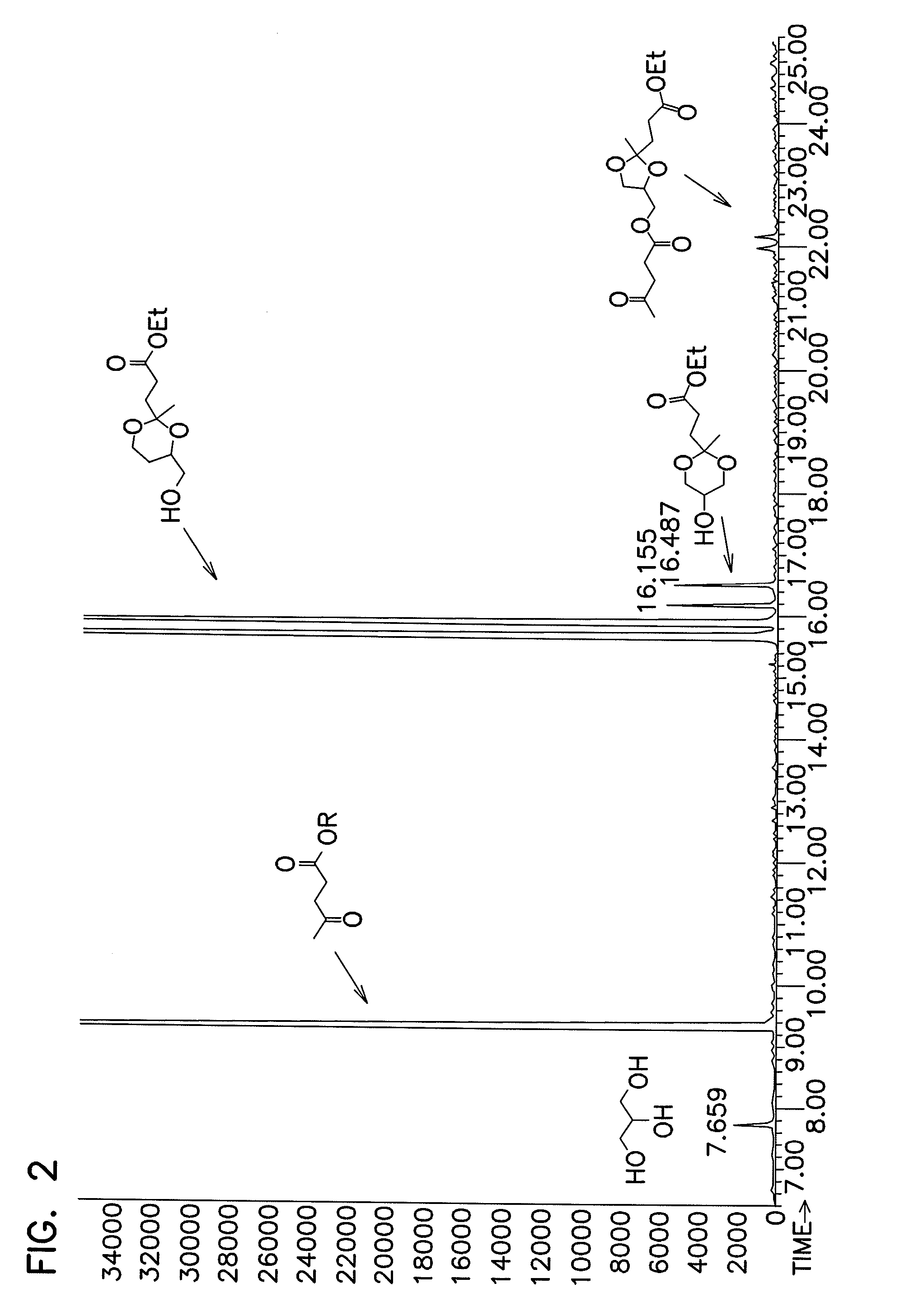Method of Making Ketals and Acetals
a technology which is applied in the field of preparation of ketal and acetal compounds, and achieves the effects of less side product formation, high yield of ketal or acetal, and faster reaction ra
- Summary
- Abstract
- Description
- Claims
- Application Information
AI Technical Summary
Benefits of technology
Problems solved by technology
Method used
Image
Examples
example 1
[0089]The acid number of ethyl levulinate (A) was measured using ASTM D664-07. The resulting measurement is shown in Table 1. The acid number was also converted to molar equivalents of acetic acid per mole of levulinic acid and is shown as % acid in Table 1.
[0090]Ethyl levulinate (A) was then distilled using standard laboratory techniques, resulting in ethyl levulinate (B). The acid number of (B) was also measured using ASTM D664-07, and the % acid was calculated based on this number as for (A); this value is shown in Table 1.
[0091]Subsequently, ethyl levulinate (B) was passed through a column of LEWATIT® GF 505 medium-basic anion exchange resin (obtained from the Lanxess Company of Pittsburgh, Pa.) to result in ethyl levulinate (C). Acid number of ethyl levulinate (C) was measured using ASTM D664-07, and the % acid was calculated based on this number as for (A); this value is shown in Table 1.
[0092]Ethyl levulinate (A) was stirred in a flask with 10 wt % of basic alumina (M) for on...
example 2
[0093]A 3-neck, 500 mL round bottom flask was charged with 90.02 g (0.53 moles) of (C) and 12.87 g (0.14 moles) of (E). The contents of the flask were observed to consist of a heterogeneous mixture of two liquid phases. The flask was equipped with an overhead mechanical stirrer, a Dean-Stark separator with an overhead condenser, and a thermocouple extending below the surface of the flask contents. The contents of the flask were blanketed with a nitrogen stream and heated to 110° C. while stirring. Once the contents were at 110° C., 1.33 μL (2.5×10−5 moles) of (H) was added into the flask below the surface of the contents by pipette. The contents of the flask began to bubble. The initial pressure in the flask was set to 300 Torr, and pressure was then ramped from 300 Torr to about 30 Torr over about 7 min. The contents of the flask were stirred for an additional 13 min at 25-30 Torn During this time, a distillate was collected in the Dean Stark separator. The distillate was observed ...
examples 3-38
[0095]The procedure according to Example 2 was used to produce the data shown in Table 2. The catalyst identity, catalyst concentration, reactants, ratio of reactants, reaction temperature, and reaction time was varied as shown. In each of the reactions except Examples 25-27, GC-MS was utilized to measure percent conversion and the amount of transesterification side-reactions similarly to Example 2.
[0096]Examples 25-27 employed ethylene glycol, which could not be assayed by GC-MS due to its volatility. These reactions were instead analyzed by 1H NMR. The products formed in Example 26 could not be analyzed by 1H NMR due to the large proportion of transesterification products: the peaks corresponding to the transesterification products interfered with peaks corresponding to the 1:1 adduct.
[0097]Examples 3 to 38 show that a relatively low number of equivalents of acid catalyst, for example 1×10−4 equivalents of acid catalyst, per mole of limiting reagent, produced high yield of the des...
PUM
 Login to View More
Login to View More Abstract
Description
Claims
Application Information
 Login to View More
Login to View More - R&D
- Intellectual Property
- Life Sciences
- Materials
- Tech Scout
- Unparalleled Data Quality
- Higher Quality Content
- 60% Fewer Hallucinations
Browse by: Latest US Patents, China's latest patents, Technical Efficacy Thesaurus, Application Domain, Technology Topic, Popular Technical Reports.
© 2025 PatSnap. All rights reserved.Legal|Privacy policy|Modern Slavery Act Transparency Statement|Sitemap|About US| Contact US: help@patsnap.com



